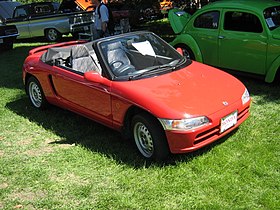
The Honda CR-X, originally launched as the Honda Ballade Sports CR-X in Japan, is a front-wheel-drive sport compact car manufactured by Honda from 1983 until 1991 with nearly 400,000 produced during this period. The first-generation CRX was marketed in some regions outside Japan as the Honda Civic CRX. Although there are many supposed definitions for the initialism CR-X, the most widely accepted is "Civic Renaissance Experimental".

The Honda Accord, also known as the Honda Inspire in Japan and China for certain generations, is a series of automobiles manufactured by Honda since 1976, best known for its four-door sedan variant, which has been one of the best-selling cars in the United States since 1989. The Accord nameplate has been applied to a variety of vehicles worldwide, including coupes, station wagons, hatchbacks and a Honda Crosstour crossover.
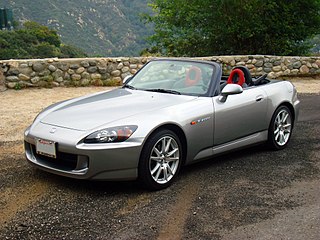
The Honda S2000 is a front-mid engine open top sports car that was manufactured by Japanese automobile manufacturer Honda, from 1999 until 2009. First shown as a concept car called the SSM at the Tokyo Motor Show in 1995, the production version was launched on April 15, 1999, to celebrate the company's 50th anniversary. The S2000 is named for its engine displacement of two litres, while "S" stood for "sports" carrying on in the tradition of the S500, S600, and S800 roadsters of the 1960s.
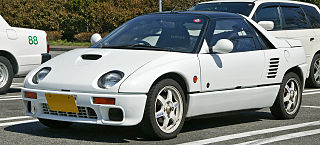
The Autozam AZ-1, known by the framecode PG6SA, is a mid-engined kei-class sports car, designed and manufactured by Mazda under its Autozam brand. Suzuki provided the engine as well as the inspiration for the design.

The Suzuki Cappuccino is a sports car produced by the Japanese company Suzuki from 1991 to 1998. It is a two-seater roadster with a detachable hardtop that is designed to meet Japanese kei car regulations.

The Daihatsu Copen (Japanese: ダイハツ・コペン, Daihatsu Kopen) is a 2-door convertible kei car built by the Japanese car company Daihatsu. It debuted at the 1999 Tokyo Motor Show, as the Daihatsu Copen concept. The second generation model debuted as the Kopen (Future Included) at the 2013 Tokyo Motor Show.

The Daihatsu Fellow Max is a small Japanese automobile in the Kei car class. Originally introduced as the Daihatsu Fellow, the name was partially retained for its successor, the Max Cuore (1977), and then revived in 2000 for the Daihatsu Max.
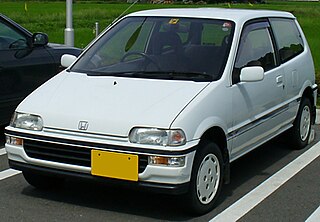
The Honda Today is a kei car produced by Japanese automaker Honda beginning in 1985. It was replaced by the Honda Life in 1998.

The Acura CSX is Acura's subcompact executive car exclusively designed for the Canadian market. Like the EL, it was only available in Canada and built in Alliston, Ontario, Canada. For the 2013 model year, the ILX was introduced as the CSX's replacement and is available in both the United States and Canada.

The Honda Acty is a series of cabover microvans and kei trucks produced by the Japanese automaker Honda from 1977 to 2021, designed for the Japanese domestic market (JDM). "Acty" is short for "Activity".

The Honda Life is an automobile nameplate that was used on various kei car/city cars produced by Honda: passenger cars, microvans, and kei trucks. The first series of the nameplate was built between 1971 and 1974, with the nameplate revived in 1997 and used until 2014. The Japanese-market Life has rarely been marketed outside Japan.
The Honda Vamos is a leisure vehicle originally produced by Japanese automaker Honda from 1970 to 1973, and reintroduced again as a trim level of the Honda Acty microvan starting in 1999. Its name, "Vamos", is Spanish and Portuguese for "let's go".

A microvan is a van or minivan which is within the Japanese kei car classification or similar, and is smaller than a mini MPV. In China, these vehicles are nicknamed miàn bāo chē because of their shape. Similarly, in several Hispanic American countries, these vehicles are called pan de molde, which means "bread loaf". In Indonesia, it is commonly called a minibus due to their tall roof, perceived as resembling a miniature bus; the term is also used generally to refer to any type of three-row MPVs.

The Honda Civic Type R is a series of hot hatchback and sports sedan models based on the Civic, developed and produced by Honda since September 1997. The first Civic Type R was the third model to receive Honda's Type R badge. Type R versions of the Civic typically feature a lightened and stiffened body, specially tuned engine, and upgraded brakes and chassis, and are offered only in five- or six-speed manual transmission. Like other Type R models, red is used in the background of the Honda badge to distinguish it from other models.

The Daihatsu Opti is a kei car produced by Japanese automaker Daihatsu from 1992 to 2002, which replaced the Leeza. It was available with a 658 cc petrol engine and either front- or four-wheel drive, and marketed as a more upmarket variant of the Mira. The name "Opti" refers to both "optimistic" and "optimum".

The sixth-generation Honda Civic is an automobile produced by Honda from 1995 until 2000. It was introduced in 1995 with 3-door hatchback, 4-door sedan and 2-door coupe body styles, replicating its predecessor's lineup. The sixth-generation Civic offered two new 1.6-liter 4-cylinder engines and a new continuously variable transmission (CVT) on the HX model. The coupe and sedan are 2.3 in (58 mm) longer and the hatchback is 4.3 in (109 mm) longer than the previous-generation Civic. This was the last generation of Civic to have front double-wishbone suspension, as the succeeding seventh generation would change the front suspension to a MacPherson strut.

The E0 series is a three-cylinder gasoline engine developed and manufactured by Honda, with a total displacement of 656 cc. The engine is intended for kei car applications. The E05A and E07A were partially replaced by the Honda P engine but as of 2020 the E07Z engine still saw use in the Acty truck.

The Honda S660 is a sports car in the kei class manufactured by the Japanese company Honda from 2015 until 2022. It is a two-seater with a targa top and a transverse mid-engine and rear-wheel-drive layout. It is the successor to the Honda Beat, and the Honda S2000.

The first generation Honda NSX, marketed in North America and Hong Kong as the Acura NSX, is a 2-seater, mid-engine sports car that was manufactured by Honda in Japan from 1990 until 2005.
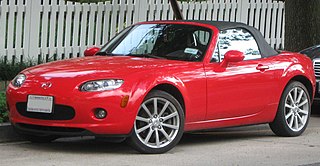
The Mazda MX-5 (NC) is the third generation of the Mazda MX-5 manufactured from 2005 to 2015. At its introduction in 2005, it won the Car of the Year Japan Award and made Car and Driver's 10Best list from 2006 to 2013.
